African Travel and Tourism
10 Popular Places to Visit in Ghana
These 10 popular places to visit in Ghana is worth visiting while in the country. It gives you a great experience and you will be able to learn a lot about the culture of Ghana. In no particular order here are 10 amazingly places to visit in Ghana.
Table of Contents
Black Star Square
Black Star Square, also called Independence Square, is a major public square in Accra, Ghana, located in the city’s commercial district. It is a well-known landmark and a popular tourist destination because of its historical significance and stunning architecture. It is one of the world’s largest public squares and a major landmark in the city. A number of monuments can be found in the square, including the Black Star Gate, a triumphal arch commissioned by Ghana’s first president, Kwame Nkrumah. The square also serves as a venue for national celebrations, military parades, and concerts. It is a popular tourist destination and represents Ghana’s independence and national pride. This is a must visit place and why we added it to our 10 popular places to visit in Ghana.


Profile Overview – Black Star Square
Name: Black Star Square, (Independence Square)
Location: Accra, Ghana
Construction: Begun in 1957, completed in 1961
Construction Purpose: To commemorate Ghana’s independence from British colonial rule in 1957
Central Monument: Black Star Gate, a triumphal arch topped with a black star, the symbol of Ghana
Capacity: Stands that can seat 30,000 people
Current Status: Main public square in Accra, used for national celebrations, parades, and cultural events
Current Significance: Commemorates Ghana’s independence from British colonial rule in 1957. Serves as a symbol of Ghana’s independence, unity, and national pride
Cape Coast Castle
Cape Coast Castle is a UNESCO World Heritage Site and a former slave castle. It is now a museum to shed light on the dark past of transatlantic slave trade. The castle was is a large fortified complex on Ghana’s Cape Coast coastline. The Portuguese built the castle in the 16th century. It was later occupied by the Dutch, Swedes, Danes, and, finally, the British. However, as a gold and slave trading post, the castle became one of the most notorious slave castles on the African coast. The dark dungeons of the castle and the Door of No Return bear witness to millions of people’s suffering. Furthermore, today, Cape Coast Castle stands as a reminder of the African people’s suffering as well as the human spirit’s resilience and fight for freedom and equality.


Profile Overview – Cape Coast Castle
Name: Cape Coast Castle
Location: Cape Coast, Ghana
Construction: Begun in 1610, completed in 1653
First Occupants: Portuguese
Subsequent Occupants: Dutch, Swedes, Danes, British.
Original Purpose: Trading post for gold and slaves.
Current Status: UNESCO World Heritage Site and museum.
Current Significance: Serves as a reminder of the horrific history of the transatlantic slave trade and stands as an appeal to humanity to never again commit such injustice against humanity.
Elmina Castle
The UNESCO World Heritage Site Elmina Castle stands as evidence of the painful history of the transatlantic slave trade. This castle, on the Ghanaian coast, has witnessed centuries of human suffering and resilience. Originally constructed by the Portuguese to serve as a central trading hub for gold and later for enslaved Africans, the castle now stands as a museum dedicated to preserving and recounting the stories of those who have passed through its gates. Visitors can visit the castle’s different chambers with the assistance of trained experts, who provide insights into the lives of enslaved Africans as well as the broader history of the transatlantic slave trade.
Its significance extends beyond its role as a museum. It serves as a sobering reminder of the human cost of slavery as well as the resilience of the human spirit. The castle’s presence is a powerful call to action, urging us to confront past injustices and commit to a world where such atrocities never happen again. Despite the castle’s painful history, it is critical that all humans who are capable of visiting do so. Many visitors have gained a greater appreciation for humanity and the freedoms that are often taken for granted.
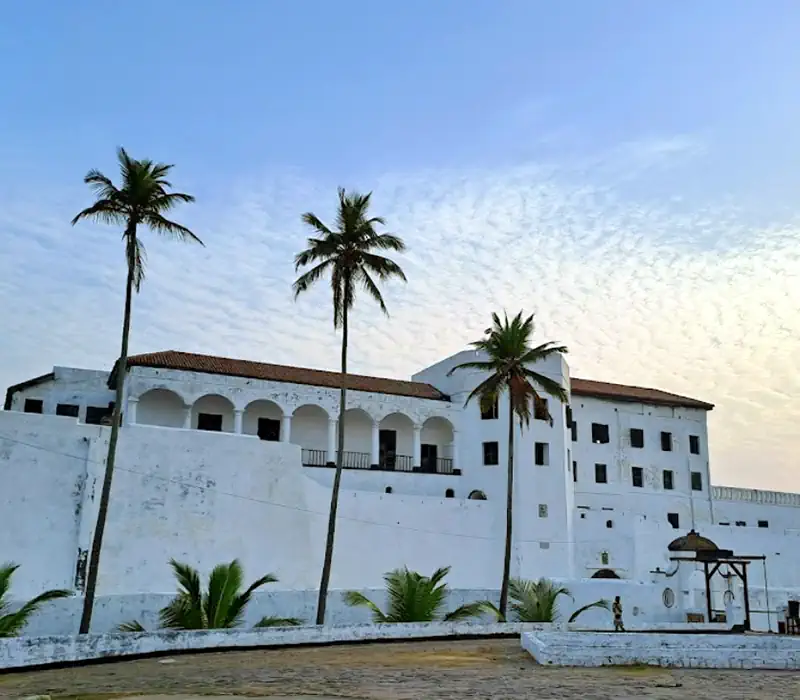

Profile Overview – Elmina Castle
Name: Elmina Castle, also known as São Jorge da Mina (“St. George of the Mine”)
Location: Elmina, Ghana
Construction: Begun in 1482, completed in 1492
First Occupants: Portuguese
Subsequent Occupants: Dutch, British
Original Purpose: Trading post for gold and slaves
Current Status: UNESCO World Heritage Site and museum
Current Significance: Stands as reminder of the dark history of the transatlantic slave trade. Additionally, it now serves as a beacon for education, cultural exchange, and a renewed commitment to African and human dignity.
Kwame Nkrumah Memorial Park and Mausoleum
The Kwame Nkrumah Memorial Park and Mausoleum is a memorial complex commemorating Ghana’s first president, Kwame Nkrumah. The park, which is located in Accra, Ghana, has grounds, a museum, and the mausoleum where Nkrumah’s remains are laid to rest. The park’s exhibits reflect on Nkrumah’s amazing journey from humble beginnings to prominence as a leader in the Pan-African movement. In addition, the stunning architectural features of the mausoleum pay homage to Kwame Nkrumah.
Furthermore, the Kwame Nkrumah Memorial Park and Mausoleum is more than just a historical place; it is a living memorial to a visionary leader who left his impact on the African continent. Moreover, it is a place for learning, reflection, and inspiration, a testament to the strength of individual will and the transformational power of collective action.


Profile Overview – Kwame Nkrumah Memorial Park and Mausoleum
Name: Kwame Nkrumah Memorial Park and Mausoleum
Location: Accra, Ghana
Construction: Begun in 1990, completed in 1992, renovated in 2022.
Significance: Commemorates the life and legacy of Kwame Nkrumah, the first president of Ghana. Additionally, it serves as a symbol of Ghana’s independence, Pan-Africanism. and a space for education and reflection on Ghana’s history.
Features and Activities:
Here are some activities you can enjoy when visiting Kwame Nkrumah Memorial Park and Mausoleum:
- Stroll through the serene gardens.
- Explore the Kwame Nkrumah Museum.
- Visit Kwame Nkrumah’s Mausoleum.
- Attend cultural events and workshops.
- Explore the Presidential Library.
Mole National Park
Mole National Park is a UNESCO World Heritage Site. The park is a wildlife enthusiast’s paradise, with opportunities to see elephants, lions, leopards, and other savanna animals. The wide untamed landscapes and different habitats of the park sustain a diverse range of species of animals.
Elephants appear to be the kings of Mole National Park, freely roaming the savannas. The parks are home to numerous kinds of big cats, antelopes, buffalo, hartebeest, graze in herds, warthogs, and monkeys. Furthermore, the park’s different habitats sustain approximately 300 bird species, ranging from eagles to tiny sunbirds. Mole National Park is an invitation to interact with nature, and immerse yourself in the raw beauty of the savanna. It allows you the chance to enjoy the delicate balance of life that flourishes within this wilderness
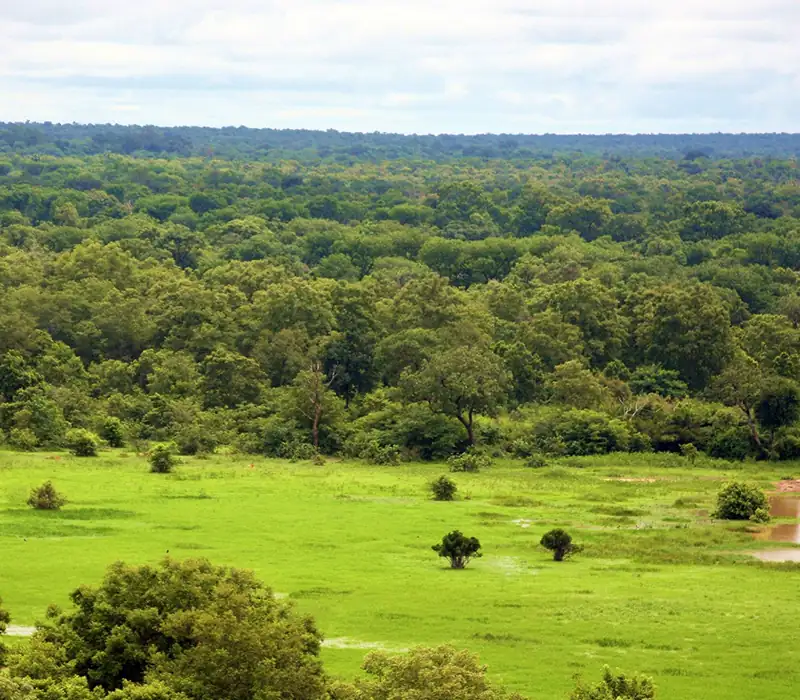
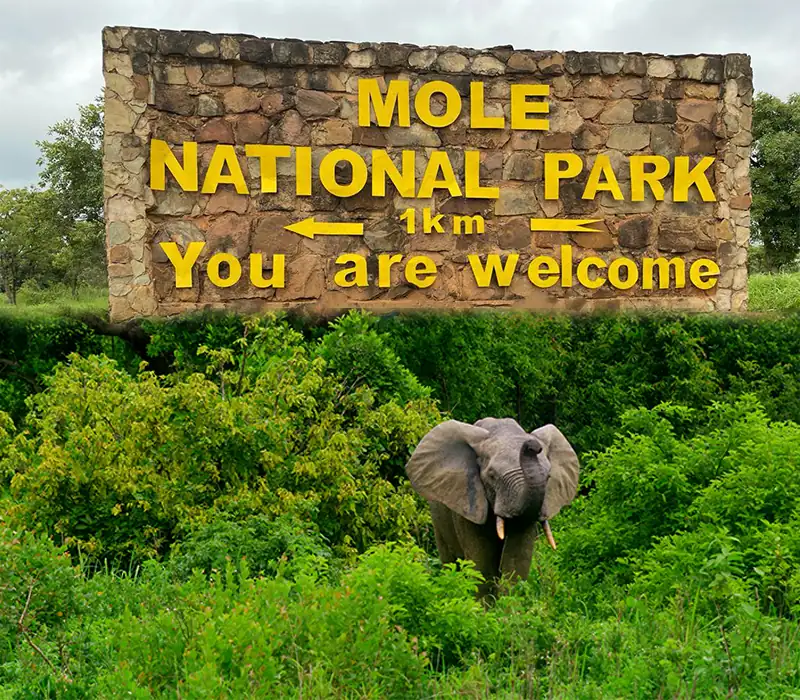
Profile Overview – Mole National Park
Name: Mole National Park
Location: Northern Region, Ghana
Establishment: Established in 1958
Significance: Ghana’s largest wildlife sanctuary, covering over 4,840 square kilometers. Home to a diverse array of savanna animals, including elephants, lions, leopards, and over 90 mammal species. A haven for birdwatching enthusiasts, with over 300 recorded bird species.
Features and Activities:
Here are some activities you can enjoy when visiting Mole National Park:
- Embark on game drives:
- Venture on guided nature walks, bush walks:
- Take a boat trip tour along the Mole River,
- Climb to the top of Mole Mole Hill for panoramic views of the park.
Manhyia Palace
Manhyia Palace is a beautiful two-story building that represents Ashanti splendor and culture. It is located in the heart of Kumasi, the Ashanti Region’s capital. Since its completion in 1928, the palace has functioned as the official residence of the Asantehene, the traditional ruler of the Ashanti people. The museum at the palace displays antiques, regalia, and historical documents that provide insight into the Ashanti empire’s origins and reign. Its courtyards hold traditional festivals, offering a lively glimpse into Ashanti cultural life. Manhyia Palace is a living homage to Ashanti heritage. It also connects the past and present while highlighting the Ashanti people’s legacy.
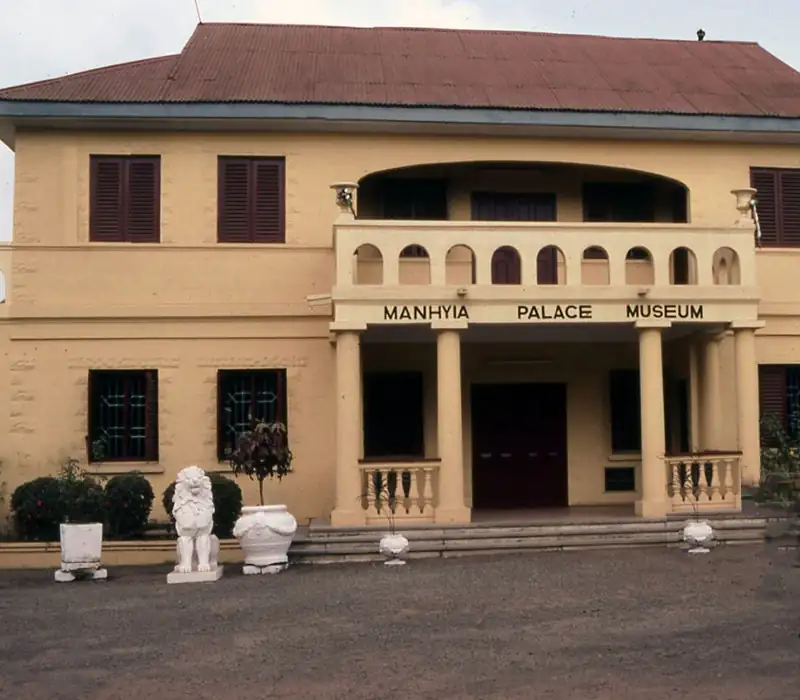
Profile Overview – Manhyia Palace
Name: Manhyia Palace, also known as the Royal Palace of Kumasi
Location: Kumasi, Ghana
Construction: Begun in 1925, completed in 1928
Significance: The official residence of the Asantehene, the traditional ruler of the Ashanti people. A symbol of Ashanti culture and heritage.
Features and Activities:
Here are some activities you can enjoy when visiting Manhyia Palace:
- Tour the Manhyia Palace Museum and grounds.
- Watch a traditional Ashanti dance performance.
Kakum National Park
Kakum National Park is a UNESCO World Heritage Site. It is an oasis for nature enthusiasts, particularly those interested in rainforests and their diverse ecosystems and a wealth of biodiversity. The park, which is located within the Assin Attandanso Forest Reserve, has about 375 square kilometers of rainforest and is home to several plant and animal species. The Park is an important refuge for endangered species, safeguarding them from challenges like habitat degradation and poaching. Elephants freely wander, monkeys hang from branches, and birds of all colors and sizes fly among the trees.
Kakum National Park exemplifies Ghana’s commitment to conservation and preservation of the country’s natural heritage. Visitors to the park are more than just observers; they become contributors in the critical mission of preserving this valuable ecosystem for future generations. This park as you can agree earns it spot in our 10 popular places to visit in Ghana.


Profile Overview – Kakum National Park
Name: Kakum National Park
Location: Assin Attandanso Forest Reserve, Central Region, Ghana
Establishment: Established in 1931 as a forest reserve and gazetted as a national park in 1992
Significance: One of the largest remaining tracts of undisturbed rainforest in West Africa. Conservation and protection of a diverse array of flora and fauna, and animals.
Features and Activities:
Here are some activities you can enjoy when visiting Kakum National Park:
- Take the canopy walking tour on a series of seven suspension bridges offering breathtaking views of the rainforest from above.
- Birdwatching.
- Cultural experiences.
- Guided park walking tours.
Lake Volta
Lake Volta, a vast body of water in southeastern Ghana, was created in 1965 by the construction of Akosombo Dam. It covers approximately 8,500 square kilometers and is vital to Ghana’s hydroelectric power output, producing a significant amount of the country’s electricity. Above all, the lake’s impact extends beyond energy, with irrigation improving farmland and supporting vibrant fishing towns. Lake Volta has grown in popularity as a recreational destination, with activities such as boat trips and fishing attracting people. It additionally contributed to a thriving cultural scene in which local communities demonstrate their customs and crafts through festivals and performances, providing a deeper understanding of Ghanaian heritage. Lake Volta is located in the southeastern part of Ghana and covers approximately 3.6% of the country’s land area. To sum up, The lake is also used for transportation, irrigation, and hydroelectric power generation.
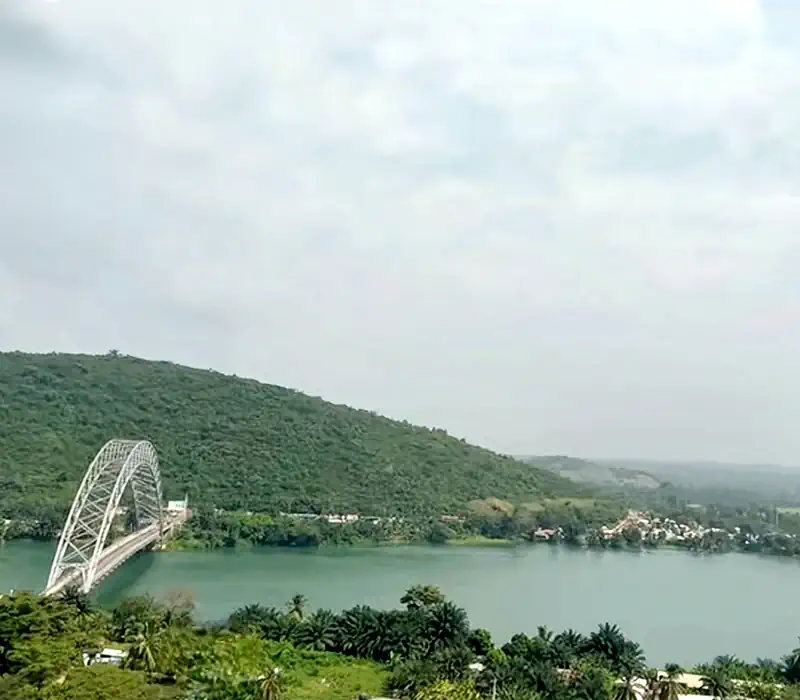

Profile Overview – Lake Volta
Name: Lake Volta
Location: Southeastern Ghana
Formation: Created in 1965 by the construction of the Akosombo Dam on the Volta River
Significance: The world’s largest artificial lake by surface area. A vital source of hydroelectric power for Ghana. A hub for transportation, irrigation, and fishing. A popular destination for recreational activities and tourism.
Features and Activities:
Here are some activities you can enjoy when visiting Lake Volta:
- Explore Lake Volta by boat: Embark on a scenic boat ride across Lake Volta and fishing trips.
- Visit Akosombo Dam: Engineering marvel and hydroelectric powerhouse.
- Engage in watersports on Lake Volta, from wakeboarding, kayaking, and canoeing.
Labadi Beach
Labadi Beach, a busy stretch of sandy beach along Accra’s coastline, is a vibrant place that offers an interesting combination of natural beauty and cultural exchanges. The beach’s popularity draws both locals and tourists looking for leisure, recreation, and a taste of Ghana’s lively coastal culture. Labadi Beach welcomes visitors to relax and soak in the warmth of the Ghanaian sun. Swimming is possible in the lovely blue seas, and the beach allows tourists plenty of area for beach activities, sunbathing, and simply taking in the beauty.
Local sellers set up stalls along the beach, selling colorful fabrics and homemade handicrafts. The smell of spices in the air encourages visitors to sample delicious Ghanaian seafood dishes. As the sun sets, the cultural heartbeat of Labadi Beach fully comes alive. Traditional drum rhythms vibrate through the air, backed by lively Ghanaian music. Visitors are frequently encouraged to participate in the celebrations, immersing themselves in the vibrant atmosphere of Ghanaian beach culture.

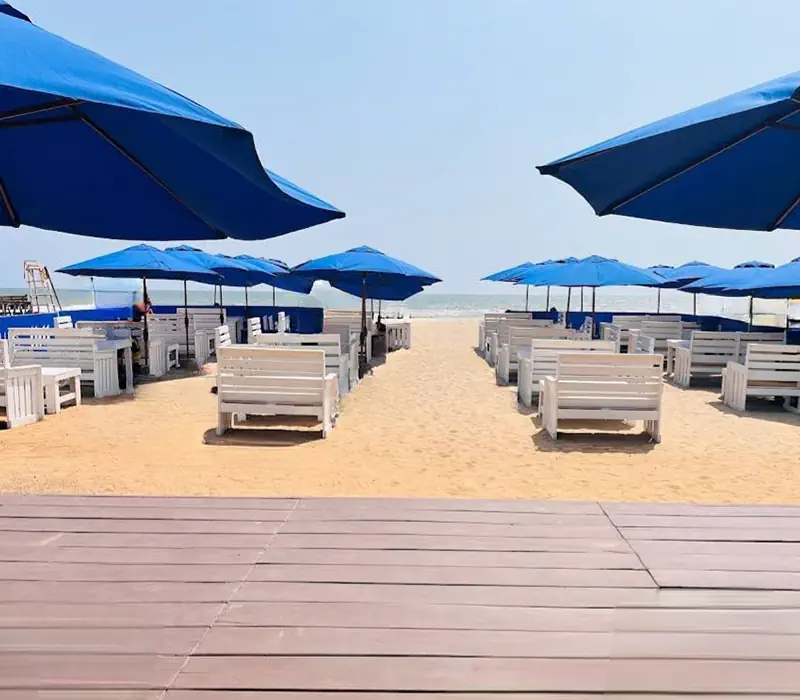
Profile Overview – Labadi Beach
Name: Labadi Beach, also known as La Pleasure Beach
Location: Accra, Ghana
Significance: One of Ghana’s most popular beaches, recognized for its vibrant environment and numerous activities. Local vendors selling crafts and souvenirs, as well as traditional music and dance performances, provide a vibrant cultural experience.
Features and Activities:
Here are some activities you can enjoy when visiting Labadi Beach:
- Relaxation and sunbathing.
- Swimming and water sports.
- Cultural experiences.
- Dining and nightlife.
- Beachfront restaurants with live music and dancing at beach bars.
Aburi Botanical Gardens
The Aburi Botanical Gardens, nestled in the green Akwapim hills, provide a tranquil place to nature lovers, and an amazing array of plant diversity. Since their inception in 1890, the gardens have acted as a center for plant research, teaching, and conservation, helping to preserve Ghana’s rich plant history. The Aburi Botanical Gardens cover around 64 hectares of land and are carefully landscaped with an array of species of plants. Visitors are led along winding walkways through flower beds bursting with color, towering trees providing shade, and collections of plants present. The gardens have more than 500 plant species, including rare and endangered species native to Ghana .
Aside its their stunning appearance, the Aburi Botanical Gardens are also important for scientific and educational purposes. Researchers from all over the world visit the gardens to study the unusual flora, which contributes to the growth of botanical knowledge. Students of all ages can take part in educational activities designed to raise knowledge of the natural world and the importance of conservation. Visitors to the gardens take part in a botanical journey, leaving with an increased appreciation and a renewed sense of responsibility for its preservation. Ghana is committed to preserving its natural heritage and developing environmental awareness.
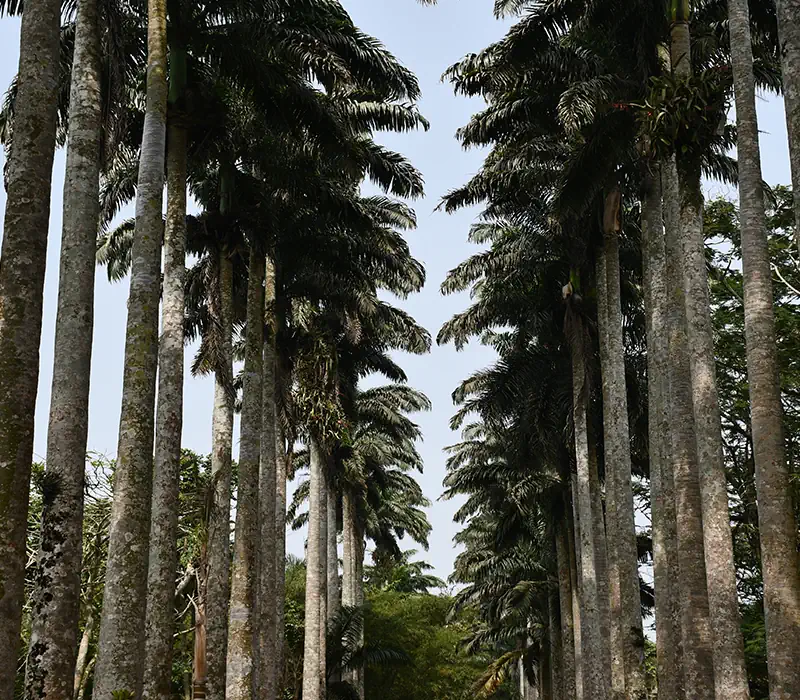

Profile Overview – Aburi Botanical Gardens
Name: Aburi Botanical Gardens
Location: Aburi, Eastern Region, Ghana
Establishment: Founded in 1890
Significance: One of the oldest and most extensive botanical gardens in West Africa. Home to a diverse array of plant species, including rare and endangered species. A haven for nature lovers, researchers, and educational groups
Features and Activities:
Here are some activities you can enjoy when visiting Aburi Botanical Gardens:
- Explore the diverse plant collections.
- Relax and enjoy the scenery. Find a quiet spot beneath a shady tree, listen to the chirping birds, and soak in the tranquil atmosphere.
- Visit the herbarium and library.
- Attend educational programs. Participate in workshops, lectures, and other educational activities focusing on various aspects of plant life and conservation.
Conclusion – 10 Popular Places to Visit in Ghana
To conclude the 10 popular places to visit in Ghana listed above are worth seeing. Ghana has everything you could possibly want, from wildlife viewing to historical immersion to beach relaxation. Furthermore, almost everyone will find something to enjoy, from the fascinating histories of Cape Coast Castle and Elmina Castle to the diverse animals of Mole National Park and Kakum National Park. We’ll see you in Ghana when you pack your luggage!
